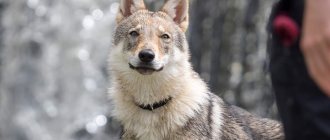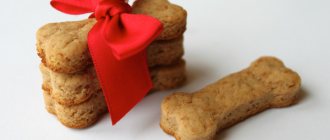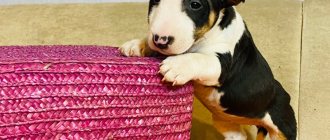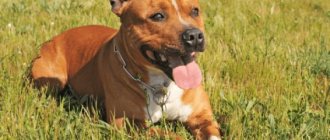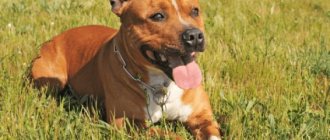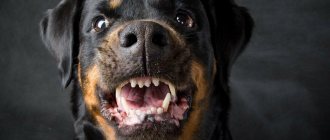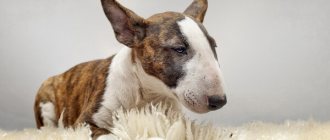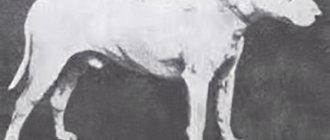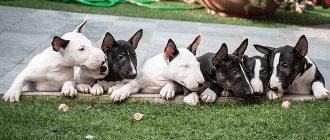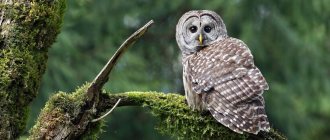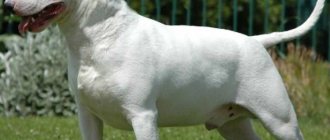13 Dog Breeds With the Highest Jaw Pressure
Modern cynology has many breeds of dogs, from decorative babies to real defenders of humans. When choosing a large dog, factors to consider include physical strength, jaw size, and bite force.
- 2 American Bandog
- 3 German Shepherd
- 4 Kangal
- 5 Tosa Inu
- 6 Rottweiler
- 7 Pit bull terrier
- 8 Dutch Shepherd
- 9 Wolfhound
- 10 English Mastiff
- 11 Doberman
- 12 Bullmastiff
- 13 American Staffordshire Terrier
How is jaw strength measured in dogs, why know this parameter
Bite force is measured in newtons (N), which can be converted to kilogram-force (1 kgf = 10 N). For fighting dogs, it is important to know this parameter, as it indicates the animal’s strong jaw, which meets the breed standards. Grip strength is also learned when training service dogs, which are then used to neutralize criminals.
Sometimes there are materials in which the bite force is measured in atmospheres. This is incorrect, since the atmosphere is a unit of pressure, i.e. force divided by area. A pressure of one atmosphere corresponds to one kgf applied to an area of one square centimeter. You don’t measure the distance between cities in km/h, do you? Likewise, when studying the jaw strength of dogs, you should not rely on atmospheres.
V. Revenko. Kennel "Strong Style"
https://otvet.mail.ru/question/28936427
Jaw clenching force is measured in several ways. The simplest, but not very accurate - the dog is forced to grab onto a wooden pine block when attacking, and then the depth of the bites is measured. Now dog handlers are abandoning this method and using special sleeves with built-in sensors.
You cannot measure the force of a dog’s bite yourself at home, as this can only be done by specially trained people using special armbands with built-in sensors.
It is important to understand that when indicating grip strength, an average number is used, since the pressure on the bitten object will differ in different parts of the jaw. The deepest puncture is made, of course, by the fangs, but the victim is squeezed most forcefully by the dog’s molars; The incisors have less strength, since they are farthest from the muscles responsible for closing the jaw. Example: the molars of an adult Rottweiler compress with a force of 1600 N, the incisors - 1400 N. It turns out that the average bite rate for this breed is 1500 N. For comparison: the force of compression of the jaws of a leopard is 1070 N, a shark - 4500 N, a wolf - 1410 N , bear - 2000 N.
Video: how to measure a dog’s bite force using a special sleeve
Description and standard
Bull Terriers are strong, medium-sized dogs with a lean build and an almost square body. They move confidently, smoothly and easily.
Representatives of this breed have pronounced sexual demorphism: males are larger, more powerful and more massive than females.
Breed standard:
- the head is ovoid, elongated, the lower jaw is clearly defined;
- the skull is rounded, inclined, the crown between the ears is flat;
- the nose is large, the nostrils are developed, the lobe is black;
- lips are dry, tightly fitting to the jaws;
- scissor bite;
- the eyes are small, triangular in shape, set obliquely and deeply, the iris is dark brown;
- the ears are small, V-shaped, erect, thin, attached to each other;
- the neck is strong, muscular, long, arched, tapering from the shoulders to the head;
- the chest is wide;
- the back is short, strong, wide, straight;
- The loin is wide, slightly convex, muscular;
- belly up;
- tail of medium length, thick at the base and slightly tapering towards the tip, set low;
- the front legs are strong, even, the length is almost equal to the depth of the chest;
- The hind legs are parallel, the thighs are muscular.
The standard does not regulate the weight and height of Bull Terriers, but these dogs must be as powerful as possible for their size.
Nine Dogs with the Most Powerful Grips
A bite from even a small, non-fighting dog can cause a lot of trouble. But there are breeds that have maximum jaw clenching force - an attack by such animals poses a real threat to life.
Rottweiler
The strength of the jaws of Rottweilers has already been mentioned above - the average compression of their jaw is 1500 N (or 150 kgf). The bite of representatives of this breed is dangerous not only for its strength, but also for the specificity of its teeth: when attacking, the dog inflicts deep lacerations and tears out pieces of flesh.
Rottweilers have a scissor bite (the upper jaw covers the lower jaw), which allows dogs to easily tear out pieces of meat when biting.
American Staffordshire Terrier
Amstaffords began to be bred specifically to participate in brutal dog fights. The breed turned out to be aggressive and hardy. Without careful training, the Staffordshire Terrier will pose a threat to everyone, including its owners. The force of jaw compression in adult dogs of this breed is 1250 N.
The main effort when biting Staffords is aimed at jerking, that is, “tearing off” a piece from the bitten object (that is, their goal during an attack is to tear apart their victim)
Pit bull terrier
Pit bulls are so dangerous that keeping them is illegal in many countries. The reason is that dogs are difficult to control, and their outbursts of aggression occur instantly. The clenching force of the jaws is 1350 N. This is less than that of a Rottweiler, but there are more cases of fatal danger from pit bull terrier bites, since these dogs, sensing blood, stop hearing the owner’s commands and tear their victim like a shark.
According to Russian health statistics for 2022, pit bulls were involved in 217 out of 569 cases of attacks by domestic dogs on people. Moreover, in half of the episodes the victims are children.
News Agency "Russian Seven"
When attacking, the pit bull knocks the enemy down and “tightly” holds him without loosening his grip
Doberman
The bite power of a Doberman is greater than that of a pit bull - 1430 N. But there are still fewer deaths after an attack by this dog, since the breed is considered less aggressive and better trainable. Doberman Pinschers are often used as police dogs to hunt down dangerous criminals who resist law enforcement.
It’s not easy to hide from the teeth of an angry Doberman, because the animal can accelerate to 35–38 km/h
Bullmastiff
Bullmastiffs are called butcher dogs because they literally cut their prey into pieces when they bite. They have a very high jaw clenching force - approximately 1650 N. This makes them the leaders in bite power among all domestic breeds. The only saving grace is that the dog is relatively friendly and, with proper upbringing, is not prone to unmotivated outbursts of aggression.
The Bullmastiff is a heavy dog, and when attacking, it will use this, trying to knock down the enemy and grab onto the most vulnerable points (throat, stomach)
German Shepherd
Although the shepherd dog looks more graceful than a pit bull or mastiff, it has a good jaw set. In a young dog (under 2 years old), the force of compression by the jaws is 1030 N, in an older and stronger shepherd this figure is 1310 N. Fortunately, there are few cases of death after attacks by representatives of the breed, since this is a very smart animal, very loyal to its owner, easy to learn commands.
When training, shepherd dogs are taught to immobilize the enemy (it will not tear the victim when biting, but will hold it for a long time - until it receives the command to release the villain)
Tosa Inu
Tosa Inu is used as a fighting dog and as a bodyguard. This is a calm, reliable, patient, manageable and attentive dog. But if she receives a command to attack or considers someone a threat, she will instantly go on the attack. The bite force is the same as that of a pit bull.
Owners consider their Tosa Inu to be good-natured, but it is important to remember that they have very strong jaws - even puppies can easily bite hard objects, such as balls.
American Bandog
The American Bandog is a powerful dog that was created by crossing an American Pit Bull and a Neapolitan Mastiff. From its ancestors the breed received a massive build and strong jaws. It is not particularly aggressive, but still requires constant monitoring and careful training. The bite force is 1180 N for young bandogs and about 1460 N for adult trained dogs.
In a fight with a pit bull, a bandog will lose, although it has stronger jaws - the reason is that bandogs have less endurance and quickly release their victim after capturing
Bull Terrier
A bull terrier without training and constant control is a killer dog. She has highly developed fighting instincts, and she sees every unfamiliar animal and person as a threat. In battle, she does not want to quickly destroy her enemy, so she does not just bite him, but chooses the most painful points - she strives to gnaw through the carotid artery and jugular vein, to bleed her opponent, inflicting multiple deep wounds with her sharp teeth. The jaw clenching force of this dog is about 1100 N. But the peculiarity is that these dogs can be trained to strengthen the jaw muscles (using the “hanging on a splint” exercise), which allows you to increase the bite power to 1450 N.
Bull Terriers hold the record for the longest time they can hold their clenched jaw at maximum tension - they can hold their bite for up to 3 hours.
Photo gallery: Other dogs with a strong bite
Even a human can bite extremely painfully, but this is not our “specialization” at all. What can we take from big dogs, whose muscles and teeth are designed to tear apart their victims and enemies. Many breeds are capable of compressing their jaws with a force of 1300 N or more - this is enough to gnaw through tendons and even break small bones with one bite. To this we must also add the sharpness of the teeth and the peculiarity of the bite, in which the dog literally tears the flesh into pieces. Of course, such features do not mean that all large dogs are bloodthirsty killers. People just need to constantly remember about the characteristics of their pets, monitor them and carefully train them in order to avoid situations in which the dog will use its powerful jaws without your permission.
Source
Dogs with the most developed muscles
Representatives of which breed have a developed muscular corset? German boxers are among the most muscular animals. They are easy to train, balanced, and can be used as guide dogs. Boxers are true defenders of their owners; they are wary of strangers, but in the family circle they are playful and obedient if they have received the right upbringing. Dogs with developed muscles also include representatives of the following breeds:
South African Boerboel
- Boerboel. African breed, banned in many countries due to increased aggressiveness. The height at the withers reaches 70 cm. The dog must be trained from an early age, but even this is not a guarantee of obedience and compliance with commands. No matter how much time it takes to train a Boerboel, it can still attack a person in a fit of aggression.
- Bull Terrier. One of the strongest breeds of medium-sized dogs with a pronounced hunting instinct. Bull Terriers are sociable, agile, and easily adapt to new conditions. The Bull Terrier has developed body and jaw muscles.
Irish Wolfhound
- Irish Wolfhound. The oldest breed, representatives of which grow up to 79 cm and can weigh about 55 kg. The dogs are used in the regiments of the Northern Irish Army, as well as to guard Buckingham Palace.
- Staffordshire Terrier. A fighting dog with large jaws, a broad chest, and strong muscles. Initially it was used for hunting large wild animals.
- German dog. A large breed of dog with developed muscles, height at the withers is at least 90 cm. There are representatives of the breed that exceed standard sizes. Thus, the Great Danes George and Zeus had a height at the withers of 110 and 111 cm, respectively.
Wendy
Big Wendy, one of the English greyhounds, is recognized as the most muscular dog in the world. Due to a genetic mutation, her muscles are hypertrophied. Since birth, Wendy has had a disruption in the production of myostatin, a protein that controls muscle growth. Despite her menacing appearance, Big Wendy has a good disposition and is devoid of aggression.
Which dog has the strongest bite - how many atmospheres are in this bite
When getting a dog, many people would like to know if it can act as a protector. Of course, the main indicator in this case is the dog’s readiness to fight. But don’t forget about physical fighting qualities. For example, many animal lovers are interested in which dog has the strongest bite. It depends on how hard she can bite her ill-wisher and whether she will injure him. Therefore, it will be useful to talk about this parameter.
A very impressive argument
What to feed?
The Bull Terrier's diet is not significantly different from other breeds. If you prefer ready-made food, opt for premium products. It is also worth considering such factors as whether the dog will participate in exhibitions, what kind of temperament and mobility it has, and whether there are any health problems.
For those who choose natural food, there are several rules:
- Daily rate: 2-3% of the animal’s weight. If the animal begins to gain weight, reduce the portions; if it loses weight, increase it.
- Meat should make up 70% of the daily requirement.
- By-products can replace meat a couple of times a week. Moreover, their volume should be twice the usual amount of meat.
According to reviews from owners, boules are prone to obesity, so nutrition must be selected carefully and taking into account individual characteristics. It is better to consult with the breeder and veterinarian.
Anatomy of a bite
In fact, the bite force of dogs of different breeds depends on two parameters: the length of the jaws and the power of the chewing muscles. Of course, the more powerful the muscles, the stronger the bite. On the other hand, in many dogs with a short muzzle the bite is not as strong, but the area of pressure is smaller. This ensures the so-called death grip.
A dog with a death grip does not necessarily have to be big and scary, like, for example, a Caucasian Shepherd. After all, a small French bulldog, thanks to its small jaw area, is capable of inflicting an equally terrible bite.
Health and life expectancy
Representatives of the Bull Terrier breed are distinguished by good health and strong immunity. The health of dogs can deteriorate if they are not properly maintained and fed. In most cases, the disease is associated with poor heredity.
Acquired ailments include diseases of the cardiovascular system, skin diseases, and a tendency to obesity. Many problems can be prevented by regularly vaccinating your animal.
The lifespan of a fighting pet directly depends on the quality of its nutrition, as well as compliance with the rules of care. The average bull terrier that does not take part in violent fighting will live from 11 to 14 years.
How is jaw strength measured in dogs, why know this parameter
The bite force of a bull terrier or other dog cannot be measured at home - this requires special equipment, which is available to specialists. First, they have to anger the dog so that it can bite the proposed armband with a sensor as hard as possible. The bite indicator is immediately displayed on the screen.
Why do you need to know this parameter at all? This is important for owners of fighting and service dogs - if the dog has an insufficiently powerful bite, this is a serious defect - it will not be able to effectively perform its function.
How to choose a bull terrier puppy
When buying a puppy, it is better to contact specialized nurseries or trusted breeders. Bull Terrier puppies bought secondhand may not be purebred or have congenital diseases.
Along with your pet, you should be given documents with information about vaccinations done. It is better to buy a puppy at the age of two months. He must be mobile and well-fed.
The cost of a purebred dog in a specialized nursery varies from 15 to 25 thousand rubles (2017). The same puppies can be purchased from a private breeder a little cheaper, their price starts from 8 thousand rubles. Prices for high-quality representatives of the breed can reach 50 thousand or more.
PS If you did not find the necessary information about the Bull Terrier breed or you are interested in a specific question, write about it in the comments.
Rating of dogs with the strongest grip
Now it’s time to talk about such an important indicator as the clenching force of dogs’ jaws - a table by breed will allow you to form the most objective opinion about a particular animal.
The German Shepherd is one of the leaders
German Shepherd
Of course, if we talk about dogs with the strongest bite, then we should definitely mention the German Shepherd. This dog is distinguished not only by its intelligence and discipline, but also by its powerful jaws.
In young dogs at the age of two years, this figure is about 1030 Newton, and in more mature dogs (3-5 years old) it even reaches 1310 N - simply an excellent parameter.
American Staffordshire Terrier
One of the undisputed leaders of dog fighting is the world famous Stafford. His indicator is almost as good as that of a shepherd dog - about 1250 N. At the same time, they are trained to work “to break away,” that is, often the dog not only grabs the enemy’s flesh, but also jerks sharply, thanks to which it inflicts simply terrible wounds.
Dutch Shepherd
But the Dutch Shepherd confidently outperforms both the Amstaff and its German relative - in this dog this figure reaches 1570 N! It is not surprising that in its homeland this dog is actively used by the military and police. A powerful bite combined with excellent discipline make her a reliable assistant.
Boxer
With a diminutive face, the Boxer may seem like a less impressive dog than those listed above. However, this is a dog with a death grip - it is precisely because of the short jaws that it is almost impossible to release such a grip.
And the compression force is not the smallest - about 1580 Newton, which is a very impressive figure.
American Bandog
The result of crossing a pit bull and a Neapolitan mastiff gave a very good result.
Even in young dogs, the bite force is about 1200 N, and in adults and trained dogs it reaches 1450 N, which is a very good indicator. So, this breed is definitely included in the TOP.
Bull Terrier
Of course, when talking about such an indicator as bite force, one cannot fail to mention this dog - one of the leaders among fighters and, perhaps, the most dangerous of all dog breeds. These are not just words - the Bull Terrier has a jaw clenching force of approximately 1100 Newtons. And this conversation is about a young, untrained dog.
If you spend enough time and effort on preparation, it is quite possible to increase this figure to 1400 N. It will easily crush even thick bones!
Doberman
But this is a rather difficult dog to raise and maintain. In general, when starting her up, you always need to keep your ears open. Moreover, the point is not only in rather high aggression and partial inadequacy (alas, this occurs in some representatives of the breed), but also in very powerful jaws.
For this breed, the figure is about 1580 N - even more than many fighting breeds.
Rottweiler
Overall, he is a smart, confident dog. But this does not prevent him from remaining a most dangerous opponent for both dogs and people, whom the Rottweiler often views in a similar capacity.
Its jaws are very powerful - they provide a force of approximately 1500 N. To this should also be added a special shape of the teeth and a scissor-shaped bite - this makes it possible to easily bite out pieces of flesh from the victim.
English Mastiff
Representatives of this breed amazingly combine a strong bite and a friendly character. By leaving such a pet with the baby, the owner can be sure that the latter is in no danger at all. The mighty dog would never harm his master’s “puppy” and, if necessary, would die protecting him. And this is a compelling argument - after all, the pressure force of the jaws reaches almost 1300 N.
Caucasian Shepherd Dog
But this is a truly terrible opponent. Moreover, we are talking not only about the harsh disposition and huge dimensions. It is almost impossible to escape from the jaws of the Caucasian Shepherd. Of course, the area of pressure here is quite large, but the power of the jaws will also unpleasantly surprise anyone who gets in this dog’s teeth.
The pressure here reaches 1300 N. Of course, when angry, such a dog can literally crush the thick tibia bone, not to mention the torn muscles. It is better not to fight such an enemy in a duel.
Bullmastiff
Another breed that could become the worst participant in dog fighting, if not for its relatively peaceful nature. But still, he is not afraid of fights and, if necessary, confidently enters the fray. Moreover, the tactics of bullmastiffs are practically win-win - he only needs to knock the enemy down, fall on him and inflict one bite - he probably won’t need more.
And if you consider that bullmastiffs usually choose the stomach or throat of the victim to attack, it becomes clear why very few experts are willing to pit their pets against these machines for killing and dismemberment.
Pitbull
The ranking of dogs with the most powerful jaws is completed by another dog fighting record holder. His indicator is 1350 N. Even more than that of the American Stafford. And to this it is also worth adding the fact that in a fight, especially at the sight of blood, the pit bull literally “blows the tower down.” He becomes almost uncontrollable - he tears everything he can reach, while practically feeling no pain.
This is what makes him such a terrible opponent - there is only one way to stop him - by finishing off the four-legged demon in dog form.
The most resilient dogs
The hardiest dog breeds are sled dogs (Siberian Husky, Alaskan Malamute, Samoyed, Laika). They are genetically predisposed to prolonged physical activity, because people have used them for centuries to transport goods over long distances. At the same time, huskies are capable of running longer distances compared to other sledding relatives due to the specifics of their body structure. There are other breeds that are distinguished by high levels of endurance:
Weimaraner
- Weimaraner. They have developed muscles and average body dimensions (see photo). They need physical and mental exercise. They can be used as running partners.
- German Pointer. A hunting breed, representatives of which are capable of developing great speed and covering long distances.
Hungarian Vizsla
- Hungarian Vizsla. Capable of covering vast distances, running on “autopilot”. At the same time, it easily covers short distances at maximum speed even in hot weather.
- Rhodesian Ridgeback. A medium-sized dog that can easily cover both short and long distances. Thanks to its short coat, it can easily withstand heat.
- German Shepherd. These animals are used in law enforcement agencies precisely because of their endurance, combined with high intelligence. You can run with them, go hiking, and even put some of your camping equipment on the animals’ backs in a special pouch.
Features of choosing a really strong dog
However, you should not think that it is the strength of the bite that makes the dog strong. In fact, if you calculate the bite force of a toy terrier, it can give odds to many giants. After all, his teeth are sharp, and the area of his jaws is very small.
But, of course, for objectivity, it is necessary to take into account not only the strength of the bite, but also the general power of the dog, the genetically inherent habit of inflicting terrible injuries. Finally, the dog must have a powerful neck so that it can securely hold the captured victim. Therefore, it is perhaps simply impossible to name the strongest dog.
Each breeder must choose a dog individually, depending on who exactly he wants to get - a watchman, a security guard, a fighter or an assistant.
A dog with powerful jaws is a potential source of danger. And you need to treat her with extreme caution, making sure to place special emphasis on education and training.
Source
History of the origin of the bull terrier
The name of the breed itself indicates its mixed origin. Purebred representatives of bulldogs and English terriers played a huge role in the development of the breed. Dalmatians also played a big role in the history of the bull terrier breed. What was the reason for the selection work?
The Bull Terrier is a relatively young breed. Its origins began in the 19th century, when such entertainment as hunting and dog fighting were in fashion. In sparring it was possible to exhibit completely different breeds. Bulldogs were particularly aggressive. However, the value of dog fighting was not only the opportunity to win a bet, but also to admire the cruel spectacle. The bulldogs, despite their power and strength, were too inactive, and sparring was boring. Therefore, adrenaline junkies decided to cross them with terriers. This is how dogs appeared, which were simply called “bull and terriers”. The bred animals were aggressive and powerful, but at the same time active and energetic. However, such “fighters” could not boast of beauty. They had crooked legs and a curved back.
The unaesthetic appearance of the Bull and Terrier forced James Hinks to continue experiments with crossbreeding. He began crossing Bull and Terriers, Bulldogs, English Terriers and Dalmatians. Some speculate that Foxhounds and Spanish Pointers were involved in the selection process. However, there is no exact data, because James Hinks did not describe his experiments. The result exceeded all expectations. The new “bulls” retained their activity and muscularity, but became more elegant. They were pure white in color and even earned the nickname “gentlemen in white.”
The white bull terrier was first shown to the world in 1862 at an exhibition. Since then there has been a surge in the popularity of the breed:
- 1887 - a club for bull terrier lovers was organized in Great Britain.
- 1907 - the same bull terrier club opened in the USA.
- 1939 – Colored Bull Terriers were recognized as a breed variety.
Interesting fact! The first boules with colored coats appeared at the beginning of the twentieth century. However, they often suffered from various diseases, especially deafness. Therefore, such representatives of the breed were for a long time prohibited from participating in exhibitions.
Dogo Argentino – 35.15 kg/cm2
The Dogo Argentino's bite force is 35.15 kilograms per square centimeter. This is significantly more than Leonbergers, but still far from other dogs. Known for its hunting abilities, the Dogo Argentino has exceptional hunting instincts and high energy levels. However, he is not as playful as other dogs. According to experts, the Dogo Argentino is not the easiest breed to train, despite the fact that it is quite intelligent and affectionate towards family members. Socialization with both other dogs and people is crucial when raising a puppy.
Character traits
Experienced dog breeders describe Bull Terriers as cheerful and loyal dogs, despite their negative reputation in society. These pets do not tolerate loneliness well, they are always happy to play with children of any age, and treat them very kindly and carefully. The character of a Bull Terrier can be described by the presence of the following qualities:
- Endurance.
- Bravery.
- Determination.
- Obedience.
The intelligence and intelligence of bull terriers can be the envy of many breeds. But they also have a significant amount of stubbornness, which can be eradicated with the help of proper education.
A dog of this breed is perfect as a best friend for active people. She will be happy to accompany you on your run. Such dogs need to devote a significant amount of time to physical activity and walks. This is how they spend energy, preventing it from transforming into aggression.
Dogo Canario – 37.96 kg/cm2
Another member of the mastiff family, the Great Dane is an ancient dog breed that was once used in wars. Despite their slightly aggressive nature, they may fit well into an active family that will exercise them regularly. Their bite force is 37.96 kg/cm2 and is combined with a strong temperament. This means that the dog needs an experienced owner. The Dogo Canario needs socialization from an early age and can be friendly and affectionate if raised with children or other pets.
Tosa Inu
The homeland of these dogs is considered to be Japan, the Tosa province. The first mentions date back to the 17th century. The ancestors of the Tosa Inu were pit bulls, Staffords, and Akita Inu. The peculiarity of this breed is its insensitivity to pain and the ability to make independent decisions. Dogs attack without barking warning. They are suspicious, but intelligent, friendly and love children.
The jaw pressure is 54 atmospheres.
English Mastiff – 38.80 kg/cm2
The English Mastiff, with a bite force of 38.80 kg/cm2, is distinguished by its large size but unusually calm character. This energetic pet is suitable for both children and adults. Training an English Mastiff can be difficult as the dog is extremely strong-willed, which when combined with its size can be quite challenging. The English Mastiff requires a lot of space to run and play, and care must be taken to ensure that the dog does not become bored, either mentally or physically.
Basics of care
Bull Terriers do not need a lot of space, so they are suitable for keeping in a small apartment. These dogs need to walk outside a lot and play active games. Provide your puppy with a private sleeping area from which he can explore the room. To avoid allergies, buy your dog a bed only made from natural material.
The owner will not need much knowledge about the care and maintenance of a representative of this breed. The Bull Terrier's coat does not require trimming.
It is enough to bathe him up to four times throughout the year; dirt from the wool is removed with damp cloth wipes.
The pet requires brushing with a rubber brush once every seven days. This removes excess hair and massages the skin. It is necessary to regularly care for the ears and mucous membranes of the eyes; they are wiped with a cotton pad. Once a month, the claws are trimmed a few millimeters using special scissors.
Kangal – 52.23 kg/cm2
The first line of the rating went to the Kangal with a bite force of 52.23 kg/cm2, which is three times more than that of the Doberman. The Kangal is a Turkish dog breed with a strong protective instinct. To raise an obedient and intelligent dog, you need to have a very strong will and patience. With proper training, the Kangal makes an excellent family pet and gets along well with children. If the owner can change the territorial nature of the Kangal, he will receive a beautiful and strong comrade as a reward.
Source
Types and their description
The FCI defines 3 types of Bull Terriers:
- English - fast and energetic dogs with a white coat, bred as a result of mating bulldogs, terriers and Dalmatians;
- Staffordshire - energetic but lazy animals with significant external differences from English bowls, the coat can be brindle, black, red with white, brown, red and other colors;
- dwarf - a miniature version of the English bull terrier with a tri-colored, white or tan coat.
All these breeds are independent and only partially related to each other.
Color variations
According to the breed standard, bull terrier skin pigmentation does not matter and their coat can be:
- white is the most common color and has a solid white coat, but markings of any color on the head are acceptable;
- red - solid red coat of any shade without spots or marks;
- black - as a rule, such dogs have small white spots on the body, therefore, despite the predominance of black, the color is called two-tone;
- two-color - the wool is dyed white and another color;
- tricolor - wool of white, black and red colors (brown;
- brindle - red fur with dark stripes, or vice versa, if there are white spots on the face, the color is called brindle white.
Gray, brown, blue bull terriers and individuals with white hair that do not have colored spots on the head are not allowed for breeding.
Nurseries in Russia and the CIS
- Constellation Adomas, Moscow;
- Free Star, Moscow;
- Northern line, St. Petersburg;
- Free jump, Volgograd;
- Tor Castle, Ukraine, Kyiv;
- Impact of the Century, Ukraine, Bila Tserkva;
- Unkvir Blackstar, Ukraine, Odessa
- “Geliet”, Belarus, Minsk;
- “Tsnyanskaya hunting”, Belarus, Logoisk district, village of Tsna;
- Valais Viscount, Belarus, Bereza.
